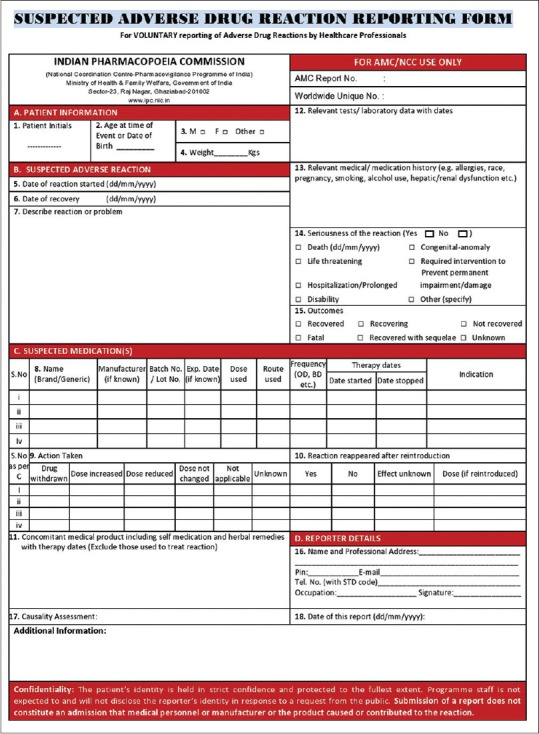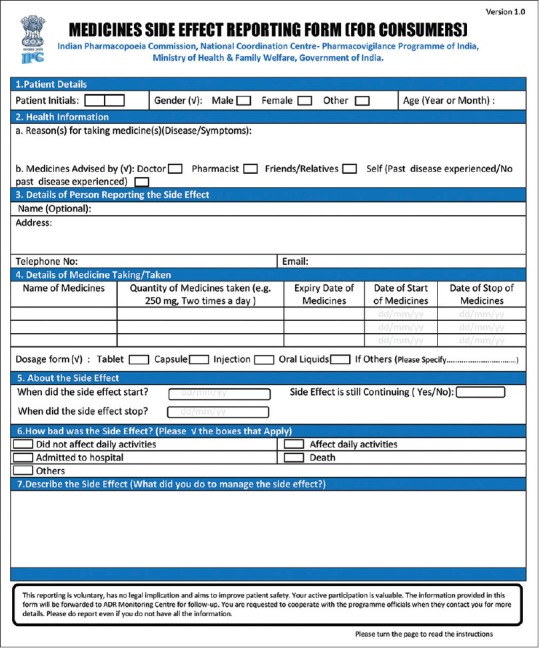Sir,
The continuous progress in medical and pharmaceutical sciences has made the availability of pharmaceutical products in the Indian market to prevent and control of several disease conditions. Irrespective of the benefits associated with the use of medicines adverse effects associated with them has emerged the challenges of monitoring Adverse Drug Reactions (ADRs) over large population base. World Health Organization (WHO) defined ADR as “A response which is noxious and unintended, and which occurs at doses normally used in humans for the prophylaxis, diagnosis, or therapy of disease, or for the modification of physiological function.”[1]
To improve public health, the safe use of medicine must be monitored through an effective pharmacovigilance (PV) system. PV is defined as the science and activities relating to the detection, assessment, understanding and prevention of adverse effects, or any other possible drug-related problems.[2]
Indian Pharmacopoeia Commission (IPC), Ghaziabad is functioning as a National Coordination Centre (NCC) for Pharmacovigilance Programme of India (PvPI). One Hundred and fifty ADR monitoring centres (AMCs) were established in various medical institutions/hospitals across India to monitor and collect ADR reports under NCC-PvPI.[3]
What to Report
PvPI encourages all types of suspected ADRs reporting whether they are known, unknown, serious, or nonserious, frequent, or rare regardless of an established causal relationship between a drug and the reaction. ADRs related with the use of allopathic medicines, vaccines, traditional medicines, medical devices, contrast media, etc., can be reported.
Where to Report
All healthcare professionals (clinicians, dentists, pharmacists, nurses) and patient/consumers can report ADRs to NCC or AMCs. The pharmaceutical companies can also send individual case safety reports for their product to NCC.
How to Report
Suspected ADR reporting forms [Figure 1] for healthcare professionals and consumers are available on the website of IPC to report ADR. To remove language barrier in ADR reporting, the consumer reporting form [Figure 2] are made available in 10 vernacular languages (Hindi, Tamil, Telugu, Kannada, Bengali, Gujarati, Assamese, Marathi, Oriya, and Malayalam). ADRs can be also reported via PvPI helpline number (18001803024) on weekdays from 9:00 am to 5:30 pm.[3] The mobile Android application for ADR reporting has also been made available to the public.
Figure 1.

Suspected adverse drug reaction reporting form
Figure 2.

Medicines side effect reporting form (for consumers)
Whom to Report
A reporter can send filled ADR reporting form directly to NCC or their nearest AMC. In case of AMC, these reports are confirmed by healthcare professionals and entered into Vigiflow and sent to NCC for further assessment.[4] These reports are then finally reviewed at NCC and committed to WHO-Uppsala Monitoring Centre. The obtained information is entered in the drug safety database, analyzed, and assessed by the experts to identify new signals.[5]
The submitted ADR report does not have any legal implication on the reporters. The patients’ identity are held in strict confidence and protected to the fullest extent.
Therefore, healthcare providers are encouraged to report ADRs for better understanding of the risk associated with the use of medicines and to safeguard the health of Indian population.
Financial support and sponsorship
Nil.
Conflicts of interest
There are no conflicts of interest.
References
- 1.World Health Organization. International Drug Monitoring: The Role of National Centres. Geneva: World Health Organization; 1972. (Technical Report Series No. 498). [PubMed] [Google Scholar]
- 2.Waller P. An Introduction to Pharmacovigilance. Southampton, UK: Blackwell Publishing; 2010. [Google Scholar]
- 3.Kalaiselvan V, Mishra P, Singh GN. Helpline facility to assist reporting of adverse drug reactions in India. WHO South East Asia J Public Health. 2014;3:194. doi: 10.4103/2224-3151.206737. [DOI] [PubMed] [Google Scholar]
- 4.Kalaiselvan V, Prasad T, Bisht A, Singh S, Singh GN. Adverse drug reactions reporting culture in pharmacovigilance programme of India. Indian J Med Res. 2014;140:563–4. [PMC free article] [PubMed] [Google Scholar]
- 5.Vivekanandan K, Rishi K, Prasad T, Arunabh T, Singh GN. Status of documentation grading and completeness score for Indian individual case safety reports. Indian J Pharmacol. 2015;47:325–7. doi: 10.4103/0253-7613.157133. [DOI] [PMC free article] [PubMed] [Google Scholar]


